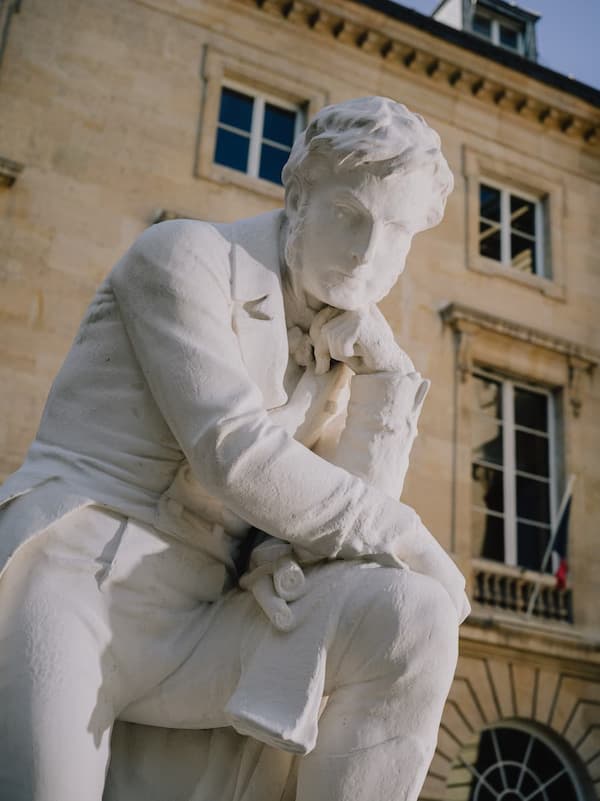
Scroll down for English version.
Cette sculpture fut imaginée en 1865 par Auguste Bartholdi (1834-1904), à la fois fasciné par l’Égypte (qu’il avait découverte lors d’un voyage en 1855-1856) et fervent admirateur de Champollion. Malgré l’enthousiasme du khédive Ismaïl Pacha pour ce projet et une participation financière du gouvernement égyptien en 1867, ce n’est finalement que dix années plus tard que la statue fut exécutée. Destinée à l’origine à la ville natale du savant, Figeac, elle fut acquise par le gouvernement et placée au Collège de France, où Champollion avait donné les premiers cours d’égyptologie en 1831. Elle y fut inaugurée en 1878 par l’administrateur Édouard Laboulaye, qui eut l’idée de la Statue de la Liberté, réalisée aussi par Bartholdi.
La statue fait directement référence au voyage d’étude que Champollion fit en Égypte en 1828-1829. La position que le sculpteur donne à Champollion peut heurter nos sensibilités contemporaines, mais telle n’était pas l’intention de Bartholdi, qui s’inspire de deux traditions : d’une part, la méditation devant les ruines des civilisations disparues, thème auquel le penseur et orientaliste Volney donna ses lettres de noblesse : « Je m'assis sur le tronc d'une colonne ; et là, le coude appuyé sur le genou, la tête soutenue sur la main, tantôt portant mes regards sur le désert, tantôt les fixant sur les ruines, je m'abandonnai à une rêverie profonde » (Les ruines ou Méditations sur les révolutions des Empires, 1789). D’autre part, le mythe grec d’Œdipe, vainqueur de la sphinge, monstre à corps de lion et à tête humaine qui terrorisait la région de Thèbes en dévorant quiconque ne pouvait trouver la réponse aux énigmes qu’il posait. Amalgamant la sphinge grecque au sphinx égyptien, Bartholdi assimile Champollion à Œdipe : « J’ai voulu rendre Champollion comme Œdipe arrachant au Sphinx son secret », écrit-il en 1867. Mais contrairement à cette tradition, Bartholdi ne représente pas les deux protagonistes face à face. Ne disposant que d’un bloc, il dut travailler sur un axe vertical qui met le savant dans une position dominante.
Bartholdi représente ainsi Champollion comme celui qui, résolvant l’énigme du sphinx, brisé à ses pieds, n’en est pas moins méditatif devant la civilisation qui se dévoile à ses yeux. Il saisit le savant dans une attitude empreinte à la fois de triomphe et d’humilité : vainqueur de l’énigme des hiéroglyphes, il entrevoit la grandeur d’une culture qui lui reste maintenant à comprendre.
Bibliographie : Julien Auber de Lapierre, « Une statue pour Champollion ou l’Œdipe qui vainquit le sphinx », dans J.-L. Fournet (dir.), Champollion 1822, et l’Égypte ancienne retrouva la parole, éditions du Collège de France, Paris, 2022, p. 108-126.